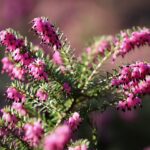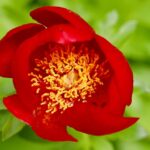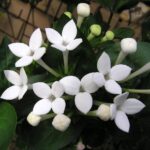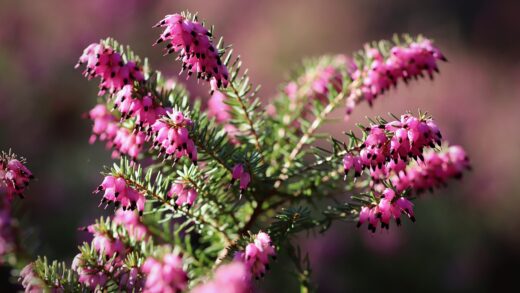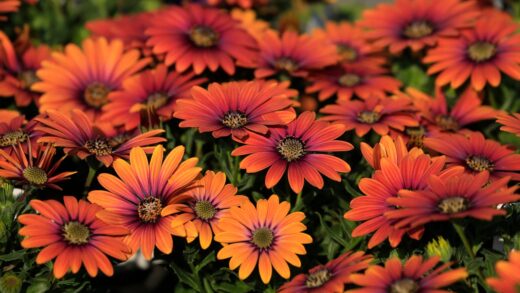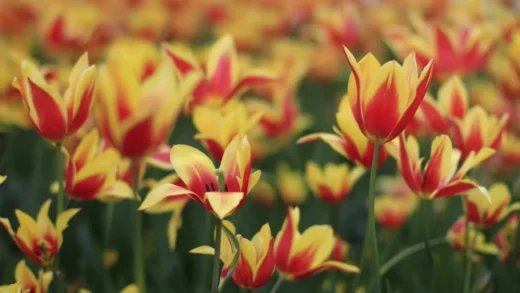Caryopteris is a shrub that truly embodies the principle of “tough love” when it comes to nutrition. It is naturally adapted to environments with lean, less fertile soils, and as such, it has very modest nutrient requirements. In the average garden, the existing soil often contains all the necessary nutrients to support healthy growth and prolific flowering without the need for supplemental fertilizers. Over-fertilizing this plant is a common mistake that can lead to a host of problems, ultimately detracting from the very qualities for which it is grown. An excess of nutrients, particularly nitrogen, can stimulate rapid, weak, and lush foliage growth at the direct expense of the desirable blue flowers.
This preference for leaner conditions means that gardeners should adopt a very conservative approach to feeding their bluebeard shrubs. In most cases, an annual application of organic matter is the best and safest way to provide a slow, gentle release of nutrients. Spreading a layer of well-rotted compost or leaf mold around the base of the plant in the early spring serves multiple purposes. It not only supplies a balanced range of micronutrients and macronutrients but also improves the soil structure, enhances moisture retention, and supports beneficial microbial life in the soil. This single annual application is typically sufficient for the entire growing season.
If the soil is known to be extremely poor or sandy, a light application of a balanced, slow-release granular fertilizer may be beneficial. If a synthetic fertilizer is used, it should be one with a balanced N-P-K (Nitrogen-Phosphorus-Potassium) ratio, such as a 10-10-10 formula. A fertilizer that is high in phosphorus (the middle number) can help to promote strong root development and flowering. The fertilizer should be applied in the early spring as new growth begins to emerge, and always at the rate recommended on the product packaging, or even at half-strength to be cautious.
It is crucial to avoid feeding Caryopteris in the late summer or autumn. Applying fertilizer late in the season can encourage a flush of new growth that will not have sufficient time to harden off before the first frosts. This tender new growth is highly susceptible to winter damage, which can weaken the overall health of the plant. The plant’s natural cycle is to slow its growth in the autumn as it prepares for dormancy, and late-season fertilization interferes with this important process. Therefore, all feeding should be concluded by mid-summer at the latest.
Understanding soil and nutrients
The foundation of a healthy Caryopteris is healthy soil. While this shrub is adaptable, it performs best in soil that is well-drained with a neutral to slightly alkaline pH. Before deciding on a fertilization strategy, it is helpful to have a basic understanding of the existing soil composition. A simple home soil test kit or a more comprehensive analysis from a local agricultural extension service can provide valuable insights into the soil’s pH and nutrient levels. This information allows for a more targeted approach, preventing the unnecessary application of fertilizers.
The three primary macronutrients that plants require are nitrogen (N), phosphorus (P), and potassium (K). Nitrogen is responsible for leafy, vegetative growth. Phosphorus plays a crucial role in root development, energy transfer, and flower production. Potassium contributes to the overall vigor of the plant, disease resistance, and water regulation. For a flowering shrub like Caryopteris, an excess of nitrogen is particularly undesirable as it promotes leaves over flowers. A balanced supply of phosphorus and potassium, however, is beneficial for a strong bloom display and robust health.
In addition to the primary macronutrients, plants also require a range of micronutrients, such as iron, manganese, and zinc, albeit in much smaller quantities. Fortunately, these micronutrients are typically present in sufficient amounts in most garden soils. The regular addition of organic matter like compost is the best way to ensure a steady supply of these essential trace elements. Compost is a complete soil amendment, providing not only nutrients but also improving soil texture and water-holding capacity, creating an optimal growing environment.
If a soil test reveals a specific deficiency, it can then be addressed directly. For example, if the soil is overly acidic (a low pH), an application of garden lime can help to raise the pH to a more suitable level for Caryopteris. Conversely, if the soil is too alkaline, elemental sulfur can be used to lower the pH. However, for most gardeners, simply focusing on building a healthy, living soil through the use of organic amendments will provide Caryopteris with everything it needs to thrive without the need for complex chemical interventions.
The best fertilization practices
The most effective and sustainable way to meet the minimal nutrient needs of Caryopteris is through the annual application of well-rotted organic matter. In the early spring, as the new buds begin to swell, applying a 2 to 5-centimeter layer of compost in a circle around the base of the shrub is the ideal practice. This “top-dressing” should extend out to the plant’s dripline. As the compost breaks down, it will slowly release a balanced array of nutrients and trace elements that are readily available to the plant’s roots.
This organic approach offers numerous benefits beyond simple nutrition. Compost improves soil structure, which is particularly important for enhancing the drainage that Caryopteris requires. It also increases the soil’s ability to hold onto moisture, reducing the need for supplemental watering during dry spells. Furthermore, it fosters a healthy soil ecosystem, encouraging the activity of beneficial microbes, fungi, and earthworms, which all contribute to the long-term health and fertility of the soil. This holistic method builds a resilient garden environment.
If a synthetic fertilizer is deemed necessary due to very poor soil conditions, timing and application method are key. A balanced, slow-release granular fertilizer is the best choice. It should be applied only once, in the early spring, as new growth commences. The granules should be scattered lightly on the soil surface around the base of the plant, avoiding direct contact with the stems. Gently scratch the fertilizer into the top layer of soil and water it in well to help it dissolve and move down into the root zone.
It is critical to follow the application rates specified on the fertilizer packaging. The temptation to add a little extra in the hope of better results should be strictly avoided with Caryopteris. Over-fertilization can cause more harm than good, leading to weak growth, reduced flowering, and even fertilizer burn, which can damage the roots. For this shrub, a lean approach is always the safest and most effective strategy, ensuring a compact, sturdy plant with an abundance of its signature blue flowers.
Signs of nutrient imbalance
Because Caryopteris has such low nutrient requirements, signs of deficiency are rare in most garden settings. However, in extremely sandy or leached soils, a plant may occasionally exhibit symptoms that indicate a lack of certain nutrients. One of the most common signs is chlorosis, which is a yellowing of the leaves while the veins remain green. This often points to an iron deficiency, which can be more prevalent in highly alkaline soils where iron becomes less available to the plant.
Other potential signs of deficiency include stunted growth, smaller than usual leaves, or a general lack of vigor. A phosphorus deficiency might manifest as purplish tints on the leaves and poor flower production, although poor flowering is far more likely to be caused by insufficient sunlight or improper pruning. It is important to rule out other potential causes, such as poor drainage, pest issues, or lack of sun, before concluding that a nutrient deficiency is the problem.
Conversely, the signs of over-fertilization are often more dramatic and damaging. The most common symptom, as previously mentioned, is excessive, lush green growth with very few or no flowers. The plant may look healthy from a foliage perspective, but it fails to perform its main ornamental function. This soft, sappy growth is also much more attractive to pests like aphids and more susceptible to fungal diseases. In severe cases of over-fertilization, you may see scorched or burnt leaf margins, which is a sign of root damage from excessive fertilizer salts in the soil.
If over-fertilization is suspected, the first step is to cease all feeding immediately. If a granular fertilizer was used, you can try to scrape away as much of it as possible from the soil surface. Watering the area thoroughly and deeply on several occasions can help to flush some of the excess salts out of the root zone. In the long term, the best remedy is to return to a more appropriate, minimal feeding regimen, relying primarily on organic matter like compost to provide nutrition. This will allow the plant to recover and return to a more balanced state of growth.
Fertilizing in containers
Caryopteris grown in containers has slightly different nutritional needs compared to its garden-grown counterparts. The potting medium has a limited volume and can become depleted of nutrients more quickly due to the regular watering that flushes them out of the pot. While the plant still prefers lean conditions, a potted Caryopteris will likely require some supplemental feeding during the growing season to perform its best. However, the same principle of moderation still applies.
A good strategy for containerized plants is to incorporate a slow-release granular fertilizer into the potting mix at the time of planting. Choose a balanced formula or one that is slightly higher in phosphorus and potassium to encourage blooms. This initial charge of fertilizer will often provide enough nutrients to last for several months. This method provides a steady, consistent supply of food without the risk of sudden, excessive doses.
Alternatively, or as a supplement later in the season, a diluted liquid fertilizer can be used. A balanced liquid feed or a “bloom booster” formula can be applied at half or even quarter the recommended strength once every four to six weeks during the peak growing period from late spring to mid-summer. It is very important not to overdo it; infrequent feeding is better than frequent feeding for this plant. Always water the plant thoroughly with plain water before applying any liquid fertilizer to avoid burning the roots.
As with garden plants, all fertilization of container-grown Caryopteris should cease by late summer. This allows the plant to slow its growth and prepare for winter dormancy. Continuing to feed it late into the season will only encourage tender new growth that is vulnerable to frost damage. By providing just enough nutrition to support healthy growth and flowering, while respecting the plant’s preference for leaner conditions, you can enjoy a spectacular display from your potted bluebeard.
📷Agnieszka Kwiecień, Nova, CC BY-SA 4.0, via Wikimedia Commons

